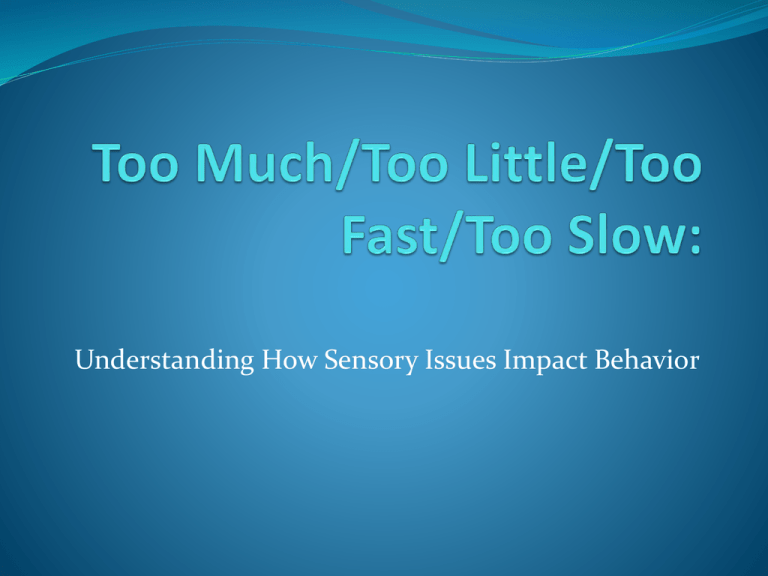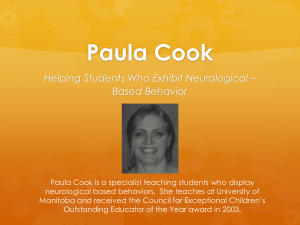Too Much/Too Little/Too Fast/Too Slow
advertisement

Understanding How Sensory Issues Impact Behavior Overview What is Sensory Processing Disorder? Neurological Disorganization: Difficulty: Taking in sensory information Interpreting sensory information Integrating sensory information Response (outcome) Inappropriate response Imagine If: “Imagine driving a car that isn’t working well. When you step on the gas the car sometimes lurches forward and sometimes doesn’t respond. When you blow the horn it sounds blaring. The brakes sometimes slow the car, but not always. The blinkers work occasionally, the steering is erratic, and the speedometer is inaccurate. You are engaged in a constant struggle to keep the car on the road; it is difficult to concentrate on anything else. Stanley Greenspan, “The Challenging Child” (1995) What if: You could see obstacles in your way but you could not make your body move in the direction you wanted to avoid them. Your clothes feel like they were made of fiberglass. Every time you tried to write with your pencil, it broke because you pushed too hard. The humming of the lights sounded louder than my voice. Every time someone touched you it felt like they were rubbing sandpaper on you. You wanted to write something down but it took you at least 5 seconds to form each letter. You can see the letter in your head but your hand will not go in the right direction to write it. You had to pull over the car 3 times on the ride here because the motion made you sick. Eight Sensory Systems Sensory systems receive information from stimuli Outside our bodies Inside our bodies It is then sent to the brain for interpretation Then: Brain generates a response Motor Behavioral This response is unique to the individual; based on personal experiences and associations. Sensory information can support or challenge a child Sensory Systems 2. Sight 5. Touch • Protective • Discriminative 6. Vestibular 3. Smell 7. Proprioception 4. Taste 8. Interoception 1. Sound Almost all children with SPD have more than one sense that is impacted Sound/Auditory System Gives ambient and focal information Discerns background noise from relevant noise Right/left spatial discrimination Associated closely with vestibular system Helps us understand movement Detects pitch, tone, frequency Foundation for language development Movement/rhythm are paired with speech Temporal and spatial orientation Earliest form of communication - relief from discomfort, attain desired needs, establish proximity Behaviors Associated With Dysfunction of Auditory Systems Afraid of moving toys Cannot locate where they are coming from Difficulty discerning mom’s voice from background noise Missing specific pitches can sound like a person talking with marbles in the mouth Sensitivity to noise children cover ears/cry Overwhelmed=overactivity and/or aggression Difficulty regulating own volume Difficulty discriminating certain sounds: “Come with me.” “See that tree.” Rule outs: hearing loss/impairment, frequent ear infections Can look like: trauma, ADHD, reactive attachment, ODD, autism Sight Foundation for bonding, spatial orientation, movement through space, social communication Shows us exactly where we are in space Works closely with vestibular, proprioceptive, and tactile systems With these systems together we move in response to the events around us Kicking/catching a ball Understand body language (a majority of communication) Reading, writing, calculation, spelling Behaviors Associated With Dysfunction of Visual Systems Overwhelmed in cluttered area (can’t find something <right> in front of them) Wearing hats or sunglasses to avoid glare (lamps instead of overhead lights) Do not know how to create their own visual boundaries Oval/circle are the same “b”, “d”, “p” are the same Rule outs: visual impairment, strabismus, amblyopia Can look like: ADHD, autism Smell/Olfactory Processed through our Limbic System • Related directly to emotion 1st to develop Foundation for bonding Protection for noxious items Important for attending/deciphering to enjoyable foods and dangerous surroundings (i.e. fire) Taste Quality of foods/liquids • Texture – crunchy, chewy • Color – white, colorful (vibrant) • Property – sweet, salty, sour Behaviors Associated With Dysfunction of Olfactory/Gustatory Systems Fight/flight response to certain restaurants, cafeteria food preparations Dinner problems/food aversions Sniff all foods before they will taste Only eat white foods (bland) Only eat spicy foods Rule outs: food allergies, illness, trauma Can look like: “picky eating”, eating disorder, ODD, reactive attachment, OCD Foods That Change Arousal: Crunchy – calming Sucking – calming Chewy – calming Salty – alerting Sour - alerting Touch/Tactile Very important in behavior Skin largest sensory system Earliest sensations infant feels Bonding/attachment/feeding/emotional responses Information about: Touch – light/deep Pressure Texture Heat Cold Pain Tactile/proprioception work together Two Systems: • Protective – respond quickly as we are protecting ourselves against something potentially harmful • Discriminative – gives us details about things. Is our little detective. Tells us internally what’s going in externally (hard, soft, round, square, hot, cold) (I.e., “If it’s square, cannot be a penny.”) Dysfunction: Hypersensitive (sensory-defensive) Hyposensitive (sensory-seeking) Combinations are common Behaviors Associated With Dysfunction of Tactile Systems Inability to distinguish similar objects without looking Cannot button coat without looking Do not like baths, haircuts, cuddling, diaper changes/toileting Twisted clothes or socks Dislike certain kinds of clothes or textures Emotionally detached Either overreact to messy hands/face or do not notice Feeding problems (suck, chew, swallow, stuffing mouth, choking) Decrease level of comfort and security; easily upset Controlling behaviors (and avoiding activities that are unpleasant to them) Overreacts to touch or is too rough with touch (headbutting, rough play) Can look like: OCD, reactive attachment, autism, ADHD, bipolar Vestibular Most primitive system Involved in neck control – coordinates with vision Gives information about your head Gravity relationship Head acceleration Organizing/soothing – linear rocking; auditory connection with ear structures Alerting – rotational movement Foundation for postural reactions Allows one to focus Gives sense of security/predictability Trust comes from grounding to the earth Behaviors Associated With Dysfunction of Vestibular System Uncomfortable with changes Doesn’t like car rides or grocery carts (backward space) Dizzy feeling Cannot navigate space around oneself Directionally – cannot tell which way they are moving Social difficulties/play Risky behaviors Can look like: ADHD, autism, anxiety, depression/withdrawal, OCD, bipolar Proprioception Bending, straightening, pulling, compressing joints and muscles – feel changes Unconscious (most of the time) Body scheme/body maps Foundational Systems Tactile, visual, vestibular, united to this system Behaviors Associated With Dysfunction of Proprioceptive Sense Erase through paper Push too hard/shove others Difficulty with sports Clumsy Toe walking Knocks over drinks Can look like: ADHD, autism, conduct disorder Interoception Sensations from sensors near organs Great modulator Suggest we are hungry, thirsty, sleepy, need to use the bathroom Behaviors Associated With Dysfunction of Introception At school nurse for aches/pains Toilet training Communication – cannot tell you what wrong Low energy Emotionally fragile Can look like: OCD, depression, anxiety, IBS, malingering Emotional Regulation Most important foundation for functioning with all types of SPD Modify your behavior/circumstances Adapt to changes remain organize calm Development Evolution Infancy – dependent on adult for regulation state By age 4 – need less external forms of regulation Older children – talk/negotiate difficulties Understand your own strategies for emotional regulation Use pretend play Behaviors Associated With Poor Emotional Regulation Fear Mood swings Doom/gloom Decreased social interactions Unproductive Peer conflicts Low self-esteem Difficulty tolerating Poor attending unpredictibility Inflexible Withdrawl Distractive Activities for Emotional Regulation Chew gum Drinking cold water Deep breathing Quiet space (“tent” or library Massage hands corner) Quiet music or white noise Dimming lights Reward Calming scents (lavender, vanilla) Visual cues Subtypes of Sensory Processing Disorder (Permission granted from SPD Foundation) www.spdfoundation.net SENSORY PROCESSING DISORDER (SPD) Sensory Modulation Disorder (SMD) SOR SUR Sensory Discrimination Disorder (SDD) SS SOR= Sensory Over-Responsivity SUR= Sensory UnderResponsivity SS= Sensory Seeking/Craving Sensory-Based Motor Disorder (SBMD) Dyspraxia Postural Disorders “Miller, L.J., Anzalone, M.E., Lane, S,J., Cermak, S.A., Osten, E.T. (2007). Concept evolution in sensory integration: A proposed nosology for diagnosis. American Journal of Occupational Therapy, 61(2), 135-140. Sensational Kids Hope and Help For Children With sensory Processing Disorder (SPD), Copyright (2006) by Lucy Jane Miller






